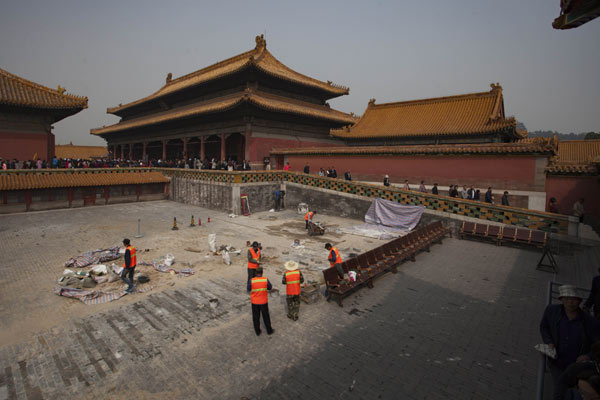Palace Museum confirms ancient relics find
Updated: 2016-05-06 08:06
By Wang Kaihao(China Daily)
|
|||||||||
The Palace Museum in Beijing has confirmed the discovery of relics from the Yuan Dynasty (1271-1368) that were buried underground in the heart of the city for more than 600 years.
|
 |
|
Maintenance work is carried out on a courtyard at the Palace Museum last month. ZHU WANCHANG/CHINA DAILY |
The museum, also known as the Forbidden City, said on Thursday that the relics had been found during maintenance work at the historic site.
The Forbidden City was home to China's imperial palace from 1420 in the early Ming Dynasty (1368-1644) until the end of the Qing Dynasty (1644-1911).
Li Ji, head of the Archaeology Department at the museum's affiliated academic research institutes, said the relics were found under the west wing of the museum during work on laying an electric cable last year, but it had taken months to appraise them and confirm their age.
"The broken tiles and porcelain pieces are direct evidence that they come from no later than the start of the Ming Dynasty."
Li also said the foundations for construction work from the Ming and Qing dynasties were found above the Yuan relics.
"These three layers of relics indicate how layouts for buildings changed through time," he said.
He added that no Yuan relics had been found previously because of "scrupulous urban construction work" in the Ming Dynasty.
"Our fieldwork shows that almost all previous construction foundations were cleared out when the Forbidden City was built, to provide impeccable detail for the new palaces."
Li said the current studies are still at a preliminary stage and it is too early to analyze the original architecture.
"Basically, we can be sure it is from an important part of a Yuan Dynasty royal palace, but it's hard to say if it was on the central axis of Beijing at that time," he said, adding that the Forbidden City today stands on this axis.
He expects further studies to reveal how this axis has evolved through history.
Li said no large-scale archaeological work will be carried out on the relics, to minimize the impact on surviving ancient architecture.
"It's like playing puzzles," he explained. "We begin small-area excavations in different spots, and can obtain a panoramic view through comparative studies."
Today's Top News
Inspectors to cover all of military
Britons embrace 'Super Thursday' elections
Campaign spreads Chinese cooking in the UK
Trump to aim all guns at Hillary Clinton
Labour set to take London after bitter campaign
Labour candidate favourite for London mayor
Fossil footprints bring dinosaurs to life
Buffett optimistic on China's economic transition
Hot Topics
Lunar probe , China growth forecasts, Emission rules get tougher, China seen through 'colored lens', International board,
Editor's Picks

|

|

|

|

|

|







